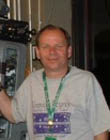|
|
 
|
|
Author
|
Topic: Fire evacuation.
|
|
|
|
|
|
|
|
|
|
|
Leo Enticknap
Film God

Posts: 7474
From: Loma Linda, CA
Registered: Jul 2000
|
 posted 08-30-2015 11:30 AM
posted 08-30-2015 11:30 AM





I had an actual fire during a show once (at City Screen, York, in 2000), and was profoundly grateful that we had a good alarm system and had done regular evacuation drills.
It wasn't actually our fire. What was originally intended to be our fourth screen, on the ground floor of the building, was, at the last minute, let to a restaurant chain and converted into an upscale Italian place with a wood-burning pizza oven. Unfortunately, this unit shared the same HVAC system as the theatre auditoria. On a Friday evening, during a packed show of American Beauty, a chimney fire started in the pizza oven (because the idiots who worked in the restaurant never swept it). The restaurant rapidly filled with smoke, which was ingested into our HVAC system and started to get into the big auditorium.
A customer there smelled the smoke and hit a break glass. The alarm system there was a two-phase one. When an alarm is triggered, it sounds in the manager's office and the booths only for 90 seconds, the idea being for the duty manager and/or projectionist to go quickly to the detector or break glass that has been triggered, establish if it's a false or a real alarm, and if false, cancel the alarm before it goes to phase 2, which is a full evacuation alarm, projection shut down, house lights up and an automated call to the fire brigade.
On this occasion, we both went in to screen one, smelled the smoke as well, and so let the full evacuation take place. The end result was a broken ankle and several cuts and bruises as people rushed through the emergency exits and down the stairs to the street, but no injuries whatsoever from smoke or fire.
The lesson for me from that night is that crowds panicking is just as dangerous as the fire itself, if not more so. After that I started reading up about infamous theatre, sports stadium and other fires that required the evacuation of many people crowded into a small space, and found that time and time again this happens. I'm not surprised that so much of a flight attendant's training is about evacuating planes in a quick but orderly way.
| IP: Logged
|
|
Mark Hajducki
Jedi Master Film Handler
Posts: 500
From: Edinburgh, UK
Registered: May 2003
|
 posted 08-30-2015 12:53 PM
posted 08-30-2015 12:53 PM




The training should be to the satisfaction of the relevant licensing authority and fire service.
Guidance for England and Wales is available from in the HSE guide to fire safety risk assessment for theatres, cinemas and similar premises guide which states:
Section 4.4
quote:
You must provide adequate fire safety training for your staff. The type of training should be based on the particular features of your premises and should:
• take account of the findings of the fire risk assessment;
• explain your emergency procedures;
• take account of the work activity and explain the duties and responsibilities of staff;
• take place during normal working hours and be repeated periodically where appropriate;
• be easily understandable by your staff and other people who may be present; and
• be tested by fire drills.
In simple premises this may be no more than showing new staff the fire exits and giving basic training on what to do if there is a fire. In more complex premises (e.g. those with more than one auditorium and those with upper tiers, levels and balconies with separate means of escape) and/or with a high staff turnover and many shift patterns, the organisation of fire safety training will need to be planned
Your staff training should include the following:
• causes of fire and how to prevent them;
• what to do on discovering a fire;
• how to raise the alarm and what happens then;
• what to do upon hearing the fire alarm (including lowering the safety curtain, if you have one);
• the procedures for alerting members of the public and visitors including, where appropriate, directing them to exits;
• the arrangements for calling the fire and rescue service;
• the evacuation procedures for everyone (including the public and contractors) in your premises to reach an assembly point at a place of total safety;
• the location and, when appropriate, the use of firefighting equipment;
• the location of escape routes, especially those not in regular use;
• how to open all emergency exit doors;
• the importance of keeping fire doors closed to prevent the spread of fire, heat and smoke;
• where appropriate, how to stop machines and processes and isolate power supplies in the event of a fire;
• the reason for not using lifts (except those specifically installed or nominated, following a suitable fire risk assessment, for the evacuation of people with a disability);
• the safe use of and risks from storing or working with highly flammable and explosive substances;
• the importance of general fire safety, which includes good housekeeping; and
• testing the effectiveness of your training by periodic fire drills.
All the staff identified in your emergency plan that have a supervisory role if there is a fire (e.g. heads of department, fire marshals or wardens and, in more complex premises, fire parties or teams), should be given details of your fire risk assessment and receive additional training.
Further guidance on training and how to carry out a fire drill is given in Part 2, Section 7.4.
Section 7.4 duplicates some of the above and adds new information. In terms of how often the training should take place the only guidance given is "as appropriate".
Management should also ensure that the training is applied in practice, action should be taken against staff propping open fire doors with fire extinguishers and other breaches of safety procedures.
Monitoring safety critical tasks are completed by responsible people (see the checklists in Section A1) is also very important.
quote: Christopher Crouch
I always add an unofficial, building specific, segment/refresher in quarterly team meetings. The official DVD/manual information isn't bad, but I think it's important to discuss the subject as it pertains to our specific circumstances/facility.
It is essential to have the fire risk assessment, procedures and training based around the actual building, not a generic example.
quote: Kris Verhanneman
And it will also be hard to act if some day it really goes wrong (example, a Saturday night around 00h, good crowded theaters and no more staff to act, it's a big cinema).
The risk assessment and procedures should cover an incident at any time there are customers in the building, not just the convenient time when you are fully staffed. Most fire drills I have seen have taken place with multiple staff per screen, not one or two staff evacuation 12 screens.
quote: Leo Enticknap
The end result was a broken ankle and several cuts and bruises as people rushed through the emergency exits and down the stairs to the street, but no injuries whatsoever from smoke or fire.
This demonstrates the advantage of the two-phase alarm, needless evacuation can cause injury and even death. Your situation was made worse by the sight and smell of smoke which would have made it more real for the customers.
| IP: Logged
|
|
|
|
All times are Central (GMT -6:00)
|
|
Powered by Infopop Corporation
UBB.classicTM
6.3.1.2
The Film-Tech Forums are designed for various members related to the cinema industry to express their opinions, viewpoints and testimonials on various products, services and events based upon speculation, personal knowledge and factual information through use, therefore all views represented here allow no liability upon the publishers of this web site and the owners of said views assume no liability for any ill will resulting from these postings. The posts made here are for educational as well as entertainment purposes and as such anyone viewing this portion of the website must accept these views as statements of the author of that opinion
and agrees to release the authors from any and all liability.
|

 Home
Home
 Products
Products
 Store
Store
 Forum
Forum
 Warehouse
Warehouse
 Contact Us
Contact Us




 Printer-friendly view of this topic
Printer-friendly view of this topic






![[Shrug]](graemlins/shrug.gif)






